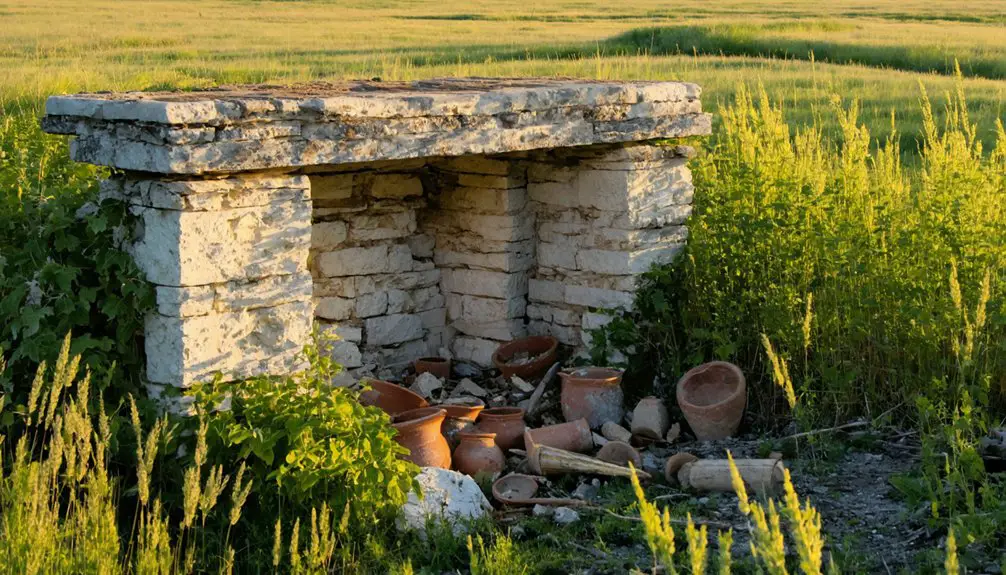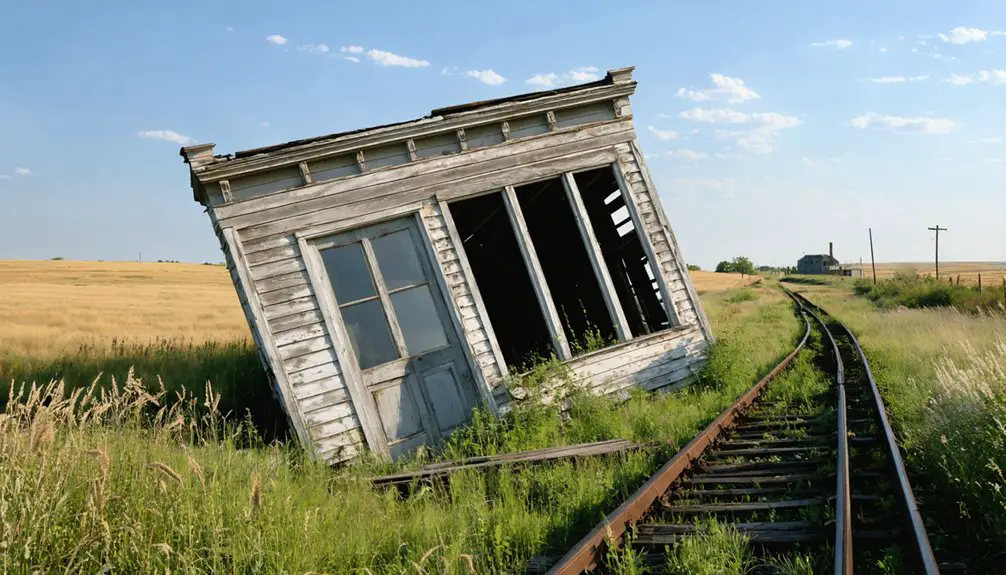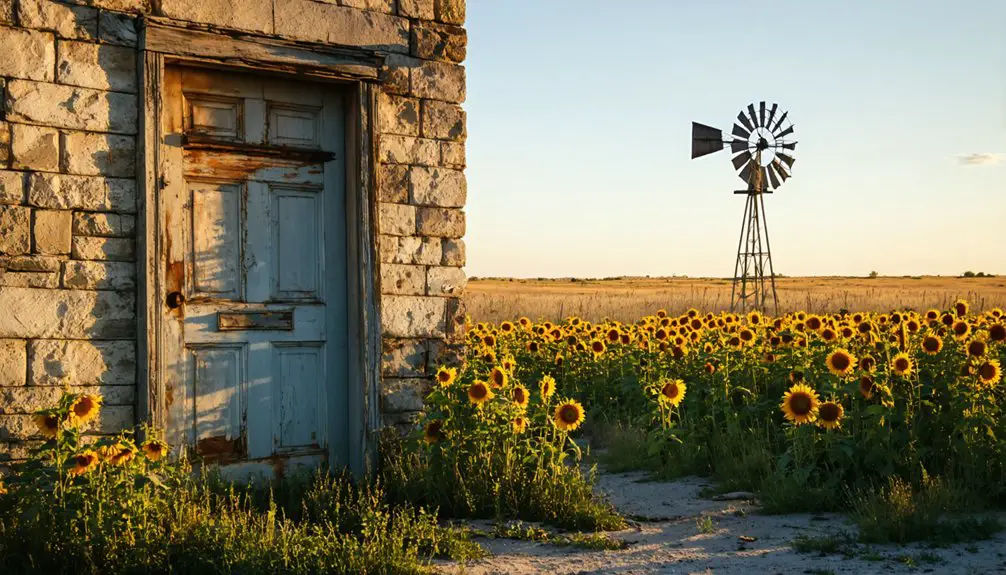You’ll find Peoria’s ghost town remnants in Franklin County, Kansas, where it emerged from Native American reserve lands in 1857. The settlement flourished briefly as a mining town, producing zinc and lead through the early 1900s, with a peak population of 125 residents in 1910. While most buildings have vanished, leaving only scattered traces and cemeteries, Peoria’s story connects deeply to the region’s Native American heritage and mining legacy across Kansas, Oklahoma, and Missouri.
Key Takeaways
- Peoria, Kansas began as a Free-State settlement in 1857 on former Peoria Indian Reserve land, with Albert Johnson establishing the first store.
- The town reached its peak population of 125 residents in 1910 during the regional lead and zinc mining boom.
- Lack of direct rail service and competition from larger nearby towns like Ottawa contributed to Peoria’s eventual decline.
- The community lost essential services, including its post office, and gradually transformed into a ghost town during the 20th century.
- Few physical structures remain today, with the site mostly converted to farmland, though historic cemeteries from the 1800s survive.
Origins of the Peoria Indian Reserve
Before establishing their Kansas reserve, the Peoria tribe and their allied groups originally inhabited the Illinois region as separate but related tribes, including the Kaskaskia, Piankashaw, and Wea peoples.
You’ll find that their journey to Kansas began with the 1832 Treaty of Lewisville, where they ceded their Missouri lands in exchange for territory near the Osage River.
Disease and intertribal conflicts took their toll, leading these groups to form the Peoria Confederation in 1849.
By 1851, intermarriage had markedly blurred tribal identity distinctions among these peoples.
Early French explorers encountered the tribe and facilitated their conversion to Roman Catholicism.
The U.S. government formally recognized this merger in the 1854 treaty, which also opened their Kansas lands to non-Indian settlement.
This marked a vital turning point in their history, as the once-independent tribes now operated as a single political entity.
The tribe later moved to Indian territory in 1867, settling in what would become Ottawa County, Oklahoma.
Early Settlement and Town Establishment
Following the Peoria Indian Reserve‘s opening to white settlers in April 1857, you’d have seen a rapid influx of pioneers claiming land at $1.25 to $2.50 per acre between Hickory Creek and Marais des Cygnes River Valleys.
Albert Johnson’s establishment of the first store anchored the new settlement, drawing more settlers and businesses to the strategically located promontory. Similar to early towns like Columbia, Peoria’s initial buildings included a log store and blacksmith.
The town’s early development reflected the broader Kansas Territory’s free-state leanings, with the community quickly organizing local governance and establishing mercantile businesses that served as both commercial and social centers. In fall of 1857, the town held its first election which included a notable dispute over land claims.
Native Reserve Location History
While the Peoria tribe originally inhabited lands in present-day Illinois, the 1832 Treaty of Lewisville forced them to cede their Missouri territories and relocate to the Osage River region in Kansas.
This Peoria relocation marked a significant shift in tribal identity as they joined with other Illinois tribes, including the Kaskaskia, Piankeshaw, and Wea, forming the Confederated Peoria tribe by 1849. Many members of the tribe accepted ex-slaves into their community during this period.
The Kansas reservation served as a consolidation point, though the tribe faced ongoing challenges from disease outbreaks and conflicts with other tribes. The Peoria language faced devastation during this period, though recent revitalization efforts began in 2022.
After the 1867 Omnibus Treaty, you’ll find that the Confederated Peoria ultimately sold their Kansas lands and moved to a new reservation in what’s now Ottawa County, Oklahoma, marking the end of their Kansas period.
Pioneer Settlement Development Patterns
As eastern Franklin County opened its Native American lands to white settlement in 1857, enthusiastic pioneers quickly claimed prime locations between Hickory Creek and the Marais des Cygnes River valleys.
You’d find these early settlers paying between $1.25 and $2.50 per acre for strategic positions near water sources, reflecting the region’s settlement dynamics.
The area’s pioneers weren’t just farmers – they’d often diversify their skills as traders and craftsmen.
Their agricultural practices laid the foundation for permanent communities, while mercantile establishments soon emerged as essential commercial and social centers.
Like many ghost towns, these settlements often disappeared when major transportation routes changed course or industries declined.
Similar to Michigan Valley’s grain elevator remnants, early settlements often centered around agricultural storage and processing facilities that supported the farming community.
You’ll notice how two-story buildings became common, combining retail space with community meeting halls.
These structures served multiple purposes, supporting both business operations and local governance before formal municipal institutions took root.
Early Infrastructure and Layout
Once settlers secured land rights in 1857, Peoria’s infrastructure took shape on a strategic promontory between Hickory Creek and the Marais des Cygnes River valleys.
The region’s first inhabitants were Native American tribes who hunted and traded in the area long before European settlement.
You’d have found Albert Johnson’s pioneering store anchoring the town’s early commercial hub, soon joined by other crucial businesses like Burton’s and Sumstine’s mercantiles.
The town’s infrastructure development centered on Jacob Sumstine’s notable two-story building, where the upper floor served as an essential community meeting hall.
You could’ve conducted business at the post office, visited local merchants, or attended gatherings where civic decisions were made.
The settlement’s position along the Fort Scott wagon trail guaranteed steady traffic, while its location near water resources supported both agriculture and transportation needs for the surrounding farmlands.
Mining Boom and Economic Growth
You’ll find the origins of Peoria’s mining boom in the late 19th century, when prospectors discovered valuable lead and zinc deposits in the region.
The Peoria Mining Land Company from New Jersey established operations that helped transform the area into a thriving mining district by the early 1900s, with ore being transported to Missouri for processing.
Mining operations, which often reached depths of 55 to 75 feet, sparked rapid economic growth that supported numerous businesses, including stores, boarding houses, and other services essential to the mining community.
Like other mining communities of the era, miners had access to two local churches where they could gather for worship and community events.
Early Mining Operations Started
While Peoria, Kansas itself wasn’t a major mining center, the surrounding region experienced significant mining activity during the 1890s, particularly focused on lead and zinc extraction.
You’ll find that mining techniques of the era relied heavily on horse drills for prospecting and shaft sinking to reach valuable ore deposits. The boom period from 1891 to 1896 saw miners facing economic challenges, including limited infrastructure and the absence of nearby railroads and smelters.
Despite these obstacles, operations persisted as market demand drove expansion. The Robert Lanyon smelter in Pittsburg, Kansas became essential for processing the extracted minerals.
Mining operations had to adapt to various regulatory hurdles and lease validity issues, but the industry’s growth continued to shape the region’s development.
Regional Economic Impact
During the early 1890s, Peoria’s regional economy experienced substantial growth as mining operations expanded throughout the surrounding area.
You’ll find that this boom transformed the local landscape, bringing jobs and prosperity while shaping the community’s future. The mining sector’s influence extended beyond resource extraction, spurring economic diversification and strengthening community resilience through infrastructure development.
- Mining operations created numerous jobs, attracting workers and their families to settle in Peoria.
- Infrastructure expansion, including roads and railways, connected Peoria to broader markets.
- Local businesses flourished as mining activities stimulated supply chain growth.
- Strategic public-private partnerships helped manage the challenges of rapid economic expansion.
The region’s growth relied heavily on balancing resource extraction with sustainable development practices, though like many mining towns, Peoria would later face the challenges of economic cycles.
Lead-Zinc Mining Prosperity
Peoria’s mining legacy began in 1891 when prospectors discovered rich lead and zinc deposits within the Tri-State Lead and Zinc District. You’d find early miners focused on shaft mining, with companies like the Peoria Mining Land Company leading the charge in ore extraction.
As mining infrastructure expanded, you’ll see how the Chicago Syndicate Mining Company built impressive milling operations by 1907, with shafts reaching depths of 160 feet.
Lead zinc extraction evolved from surface mining to sophisticated underground operations, targeting ore bodies at varying depths. The region’s success was staggering – producing 50% of America’s zinc and 10% of its lead between 1850-1950.
Small independent operators thrived alongside larger companies, creating thousands of jobs and generating immense wealth through mineral royalties and land leases on Quapaw allotments.
Daily Life in a Frontier Mining Town
Life in frontier Peoria revolved around the demanding rhythms of lead and zinc mining, where workers faced grueling days in the mines while merchants and traders kept the town’s basic needs met.
Miners endured backbreaking work extracting lead and zinc, while local merchants sustained frontier Peoria’s essential needs.
You’d find daily routines centered around makeshift buildings that served multiple purposes, from homes to stores to meeting halls. Frontier challenges meant you’d need to be resourceful, often paying high prices at merchant stores for basic supplies due to transport difficulties.
- You’d gather with others in places like Sumstine’s two-story store, which doubled as a community meeting space.
- You’d rely on local wells for water and deal with limited medical care.
- You’d work long hours either in the mines or supporting businesses.
- You’d participate in community events to balance the harsh realities of frontier life.
Native American Heritage and Cultural Impact

Before the zinc and lead mines drew settlers to the area, the land belonged to the Peoria tribe, whose complex history of displacement and resilience shaped the region’s development. Originally from Illinois, they’d been forced westward through various treaties, eventually settling in Kansas alongside other tribes like the Wea and Piankashaw.
You’ll find the Peoria heritage deeply woven into the area’s foundation. In 1855, Chief Baptiste Peoria helped establish the Paola Town Company, working with settlers to develop the region while maintaining tribal interests.
The Peoria’s cultural preservation efforts included sustaining their Algonquian language traditions and adapting to changing circumstances through confederation with related tribes. Though the town that bore their name eventually became a ghost town, their influence on local history remains significant through place names and early development decisions.
Transportation and Trade Routes
While Peoria’s early settlers benefited from its proximity to the Santa Fe Trail and local wagon roads connecting to mercantile stores, the town’s fate was largely sealed by its isolation from direct rail service.
You’ll find that the Leavenworth, Lawrence & Fort Gibson Railroad’s arrival in nearby Ottawa in 1868 created a transportation hub just six miles away, but Peoria never secured its own rail connection.
Your understanding of Peoria’s decline deepens when you consider how towns without railroad stops in the late 1800s often failed to survive, as rail transport became essential for trade and economic growth.
Railroad Connections
Despite repeated petitions to the Missouri Pacific Railroad, Peoria’s failure to secure a rail connection through nearby Imes and across the Marais des Cygnes River proved devastating to the town’s future.
The railroad significance became clear as surrounding Franklin County towns with rail access flourished while Peoria declined. You’ll find the economic implications were far-reaching, as the town’s isolation from major transportation networks severely limited its trade potential.
- The Leavenworth, Lawrence & Fort Gibson Railroad’s arrival in nearby Ottawa in 1868 shifted regional commerce away from Peoria
- Towns like Princeton, Richmond, and Garnett prospered along established rail lines
- Peoria’s businesses couldn’t compete with rail-connected communities
- The town’s absence from the rail network ultimately contributed to its transformation into a ghost town
Early Trading Posts
Along the banks of the Marais des Cygnes River, a French trader named Chouteau established one of southeast Kansas’s most significant early trading posts in the early 19th century.
Located just four miles from the Missouri-Kansas state line, this trading post became an essential hub for indigenous trade between Native Americans and settlers.
The trading post dynamics reflected the rugged frontier lifestyle. You’d find traders operating under harsh conditions, exchanging eastern goods like tobacco, weapons, and horse bridles for Native American furs.
These government-supervised posts served as more than just commercial centers – they were meeting points between cultures.
While no formal town existed until 1865, the post’s strategic river location made it critical for regional commerce and helped shape early settlement patterns along the Marais des Cygnes.
Major Wagon Routes
During the mid-1800s, Peoria, Kansas sat at a critical juncture of major wagon routes that connected Missouri Territory to the Kansas frontier.
You’d find stagecoach routes running daily through the region, carrying both passengers and freight between bustling river towns and western settlements. The Kansas Stage Company operated regular service near Peoria, charging around $10 for a 150-mile journey.
- Wagon traffic followed established trails that linked to the Oregon Trail and other westward migration routes
- Stagecoach routes connected to major river crossings, especially along the Missouri River and Marais des Cygnes
- Strategic rest stops for changing horses dotted the routes through eastern Kansas
Ghost Town Transformation
While many Kansas ghost towns experienced revival or redevelopment in later years, Peoria’s transformation followed a one-way path toward extinction.
Unlike other Kansas ghost towns that found new life, Peoria’s decline was irreversible, sealing its fate as a lost settlement.
You’ll find that the community decline began after its 1910 peak population of 125 residents, driven by technological changes in agriculture and the draw of larger nearby towns like Ottawa.
The town’s historical significance is evident in its remaining physical traces – former mercantile stores and meeting halls that once served as vibrant community centers.
As farms consolidated and the need for agricultural labor decreased, Peoria’s economic foundation crumbled. The absence of railroad connections and the loss of essential services, including the post office, accelerated the town’s fade into ghost town status.
Today, you’ll see little more than scattered remnants marking where this once-hopeful settlement stood.
Regional Mining Industry Connections

Despite its modest size, Peoria played a notable role in the Tri-State Lead and Zinc District’s mining boom of the late 19th century. When the Peoria Mining Company began operations in 1891, they’d to navigate complex ore transportation challenges due to the lack of local processing facilities.
Raw ore was hauled to distant Missouri mills, while mining techniques evolved to meet the growing industrial demands.
- The region’s mining infrastructure expanded from small-scale operations to 248 mills by 1927
- You’ll find that both lead and zinc mining connected Peoria to broader economic networks across Kansas, Oklahoma, and Missouri
- Transportation systems included river shipping, railroads, and trucks to move ore to processing facilities
- Local coal mining operations provided essential energy resources for the district’s growth
Historical Landmarks and Remnants
Today you’ll find few physical remnants of Peoria’s once-bustling settlement, as most original structures have vanished over time. The most significant ghost town relics are the area’s cemeteries, featuring headstones from the late 1800s that tell stories of early settlers. These burial grounds now serve as essential historical markers of the vanished community.
Jacob Sumstine’s two-story mercantile store, which housed a meeting hall upstairs, was once a centerpiece of community life, though it no longer stands.
The bustling Sumstine store, with its upstairs gathering space, stood as Peoria’s social heart before fading into history.
The town’s original location, six miles east of Ottawa, has transformed into farmland, with only natural landmarks like Hickory Creek and the Marais des Cygnes River valleys remaining to define where this pioneer settlement once thrived.
These features hold historical significance as the last physical connections to Peoria’s pioneer past.
Legacy in Franklin County History

Peoria’s enduring mark on Franklin County history extends far beyond its physical remnants. As one of the earliest settlements in the region, you’ll find its legacy woven into the county’s foundational story through its political, social, and moral contributions.
- A Free-State stronghold that cast a decisive vote in 1857, helping shape Kansas’s anti-slavery stance
- Home to influential leaders like Albert Johnson, who served as postmaster, county assessor, and Civil War recruiter
- Site of the contentious 1859 county seat election victory, though legal battles prevented the move
- Established key institutions including churches and schools, setting standards for community development throughout Franklin County
Even though Peoria faded after 1870, its pioneering spirit and commitment to freedom continue to influence Franklin County’s historical narrative.
Frequently Asked Questions
What Happened to the Residents When Peoria Became a Ghost Town?
Like scattered leaves in autumn wind, you’d find the residents dispersed to nearby towns, following mining jobs northward to Miami, Oklahoma, or shifting to farming and trading in growing communities.
Are There Any Known Photographs of Peoria During Its Peak Years?
You won’t find any historical archives or vintage postcards showing Peoria during its peak in the 1850s-1860s. Photography was still emerging then, and small frontier towns rarely documented themselves visually.
What Was the Population of Peoria at Its Highest Point?
While many Kansas towns boasted larger populations, Peoria’s historical peak reached just 125 residents around 1910. You’ll find these demographics reflect the modest scale of many rural settlements during that era.
Did Any Notable Crimes or Murders Occur in Peoria?
You’ll find one major historical account where Sheriff Wright shot and killed Mr. Fisher during a claim jumping dispute in 1857. The case wasn’t prosecuted due to Wright’s position as Sheriff.
Were There Any Major Natural Disasters That Contributed to Peoria’s Decline?
While natural disasters plagued many Kansas towns, you won’t find direct evidence of them causing Peoria’s decline. Instead, it’s economic decline, lack of railroad access, and changing agricultural demands that sealed its fate.
References
- https://legendsofkansas.com/peoria-kansas/
- https://www.youtube.com/watch?v=xg8SpCG-wDg
- https://www.youtube.com/watch?v=SyTlkr_4aFM
- https://www.youtube.com/watch?v=alC1wDdSVvg
- https://historyandersoncoks.org/central-city
- https://www.franklincokshistory.org/wp-content/uploads/2011/01/BRIEF-OVERVIEW-OF-THE-CONFEDERATED-PEORIA-TRIBE.pdf
- https://en.wikipedia.org/wiki/Peoria_people
- https://www.youtube.com/watch?v=aKZ0cJtJqVg
- https://www.okhistory.org/publications/enc/entry?entry=WE030
- https://dianastaresinicdeane.wordpress.com/2012/01/29/columbia-a-kansas-ghost-town-story/



